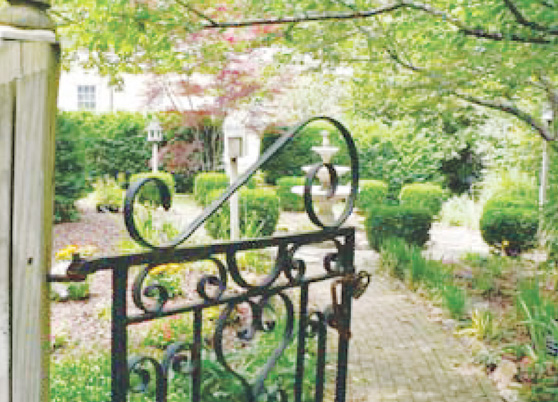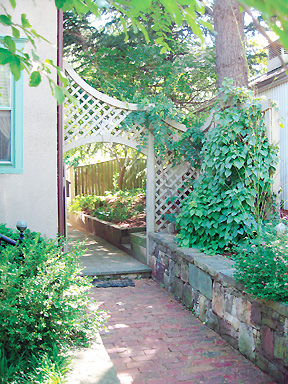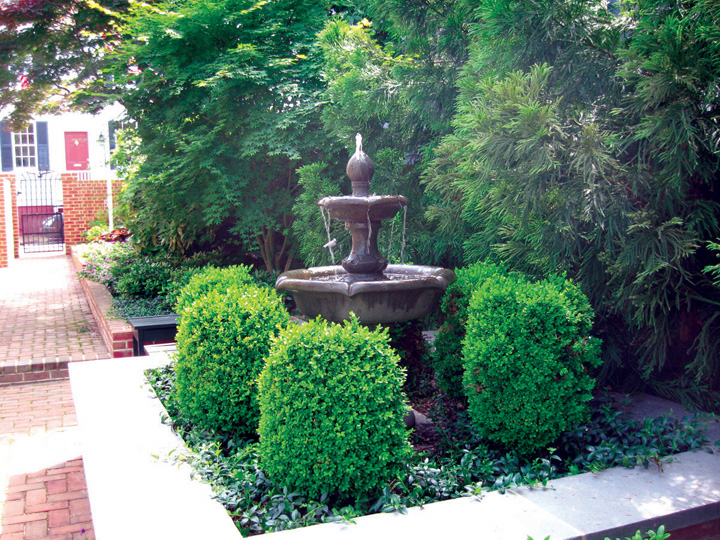 Sneak a Peek
Sneak a Peek
Once a year, Hammond Harwood House opens the gates to the capital city’s secret gardens — and invites you to look inside
by Margaret Tearman
High walls, secured gates and similar impositions block out the curious and provoke questions: What grows on the other side? Is that water I hear? What flower can smell so sweet, even from a distance?
Even on tiptoes, the answers are evasive.
Nothing tempts as much as something one cannot see, as we learned in The Secret Garden from little Mary Lennox, who sought the hidden walled-in garden and unlocked its secrets. But unlike the mysterious garden in Frances Hodgson Burnett’s classic children’s story, the secret gardens of Annapolis aren’t locked to protect broken hearts. They thrive as urban oases and quiet retreats.
Once a year, closed gates are opened to visitors, offering an unobstructed, up-close exploration of these secret gardens. No tip-toeing needed.

Germination
Carter Lively had an idea. The executive director of the historic Hammond-Harwood House had for years enjoyed garden tours in other cities — but never in Annapolis. When he shared his garden explorations with Carol Hutchinson, then president of the Hammond-Harwood House, they agreed that the private — and public — gardens of the capital city were worthy of their own tour. Funds raised by their imagined tour would benefit the Hammond-Harwood House Museum, which relied heavily on private money for its survival.
The seeds had been planted, and, in 2001, the Secret Garden Tour blossomed into reality.
The first three tours, held on a weekday, exposed the Hammond-Harwood House garden and nearby residences. About 200 garden enthusiasts attended the early tours. In 2004, the tour was moved to Sunday, and the number of garden viewers grew three-fold.
Celebrating its 10th anniversary this year, the Secret Garden Tour has grown to cover a full weekend and includes guest lecturers — at no charge — on both days. More than 600 garden peepers are expected to tour the 13 gardens: eight private secret gardens; three gardens on the expansive grounds of St. John’s College; plus Government House garden and the beneficiary of the tour, the Hammond-Harwood House Museum’s garden.
Private Blooms

The eight private gardens are quiet city spaces, created in nooks and crannies, tucked away from public view. Chosen for the tour by Hammond-Harwood House Board member Donna Schein and Annapolis landscape architect Jay Graham, these well-kept secrets are as distinct as the gardeners who grow them.
“We toured the city looking for gardens,” says Schein. “We chose a balance of gardens, some historic, some structured, some natural.”
Some of the gardens have been featured on past tours. However, as Schein is quick to point out, they are different gardens each year.
“Gardens are works in progress,” she tells Bay Weekly. “And after this winter, a number of gardens are undergoing extensive rehabilitation, particularly with trees and boxwoods.”
Not all of the gardens are completely hidden.
“Some you can see from the street,” Schein says. “But sometimes you want to get closer; you need to get closer, to see their secrets.”
Neighboring Gardens
Like the Sansing-Pilli garden. The public view begins along the front of the house and stretches out along the side. But the main attraction is out of sight. It is a lush yet structured garden where textures play harder than flowers. Sculpture and water are dominant features of this urban oasis.
Neighbors Melinda and John Colgan are grateful for the luxurious garden bordering theirs. The Colgans’ garden is also on the tour, but it is a garden of a different sort, relying more on borrowed views than horticultural excellence.
“The best thing about my garden is looking down at John Pilli’s garden next door,” says John Colgan. “And the dome of the Navel Academy chapel looks like it’s on our roof.”
The Colgans aren’t too particular about what grows in their garden. That professed indifference, along with a sense of humor, has given their garden a whimsical air.
“We’re letting nature design our garden” John Colgan says. “We have some really pretty weeds, so I just let them grow.”
Those weeds are Chinese lantern plant, whose orange flowers delight Colgan. “I have a yard full of them,” he says.
Winter damage necessitated the removal of the two large trees, and the hostas and ferns that once thrived in the cool shade are now boiling in the hot sun. Colgan is counting on tips from touring gardeners.
“That’s why I’m on the tour,” he says. “I’m looking for advice about what to do with these plants.”

 A Tiny Garden
A Tiny Garden
Louise Hayman relied on professional advice when it came to designing her tiny courtyard garden.
“My cousin gave me a consultation with garden designer Mimi Armstrong as a housewarming present,” Hayman reports.
Armstrong’s design transformed a gravel patch into a sanctuary for the busy homeowner.
“I asked for a garden that would need minimal maintenance and that could be easily admired from inside the house,” Hayman says.
The garden is small, but Armstrong carved out room for a fountain and a small table for outside dining. A stone seating area enclosing planting beds is a mix of old and new.
“We used some old brick found on the property,” Hayman says. The plants are all new additions, except for an acuba topiary and a magnolia tree.
“I’m from the lower Eastern Shore, and I grew up with magnolias,” Hayman says of her biggest tree. “The tree does make a mess, and sometimes I regret keeping it, but I so love it.”
Hayman’s garden is a model of what can be done with a very small space.
“I think people with big yards will come through my garden and be secretly envious,” she says. “I don’t want a bigger space. My garden is just enough.”
An Evolving Garden
At the home of Pat Zeno and Frank Parent, the tour features a second garden that has grown out of a former parking area.
“When we bought the house it was in bad shape, no garden at all,” Zeno says. “The back was an extension of the driveway, and it was like living in a parking lot.”
The couple has spent almost 15 years transforming the parking zone into a green haven, which is still evolving.
“We lost a lot in the heavy snow,” Zeno reports. “The garden is a work in progress as we’re always pulling things out or putting things in.”
There is no lawn — just enough room for table and chairs. An existing garden shed has been jazzed up and a fountain added. The result is a cool and calm retreat.
“We have a little secret garden,” Zeno says. “It is quiet and gives us a respite from the bustle of downtown.”

A Spirited Garden
When it comes to gardens, there are those that are secret — and those that harbor secrets.
If Leslie Woodward’s garden could talk, it could tell one heckuva good ghost story.
“When we were first looking at the house, I was walking through the yard with my son,” Woodward says. “He yelled Mom look out. I thought I was about to step on a snake.”
What caught the eye of Woodward’s son was not a reptile but three gravestones.
“I’ve been told a couple of different stories about them,” Woodward tells Bay Weekly. “One story is that there are actual graves of four people, one young woman, an old man and another holding two infants.”
The other story isn’t so personal.
“At one time, a local cemetery was being moved and one of the guys working on the house was also working on the cemetery. The story goes that when the cemetery move was finished, they ended up with three extra gravestones and those gravestones were dumped in our yard.”
However they got there, Woodward says they are there to stay.
“We had the patio built around these gravestones. A couple of the workers wouldn’t go near them. But I figure whether remains are there or not, the stones still have a bit of their spirit. So I always put flowers on them. It’s nice.”
Respecting the spirit of a place is important to Woodward. She loves old things and reuses whatever she can.
The old two-story deck on the house included an iron baluster. The deck was beyond repair, but the ironwork was salvaged and reused as garden decorations.
“The old iron is from the 1800s,” Woodward says. “They don’t make designs like that any more. It’s beautiful.”
The new patio is bordered with old bricks from the original patio.
“I don’t believe in taking away the house’s energy,” Woodward says. “I want to keep it going.”
Public Paths
Tour goers can stretch their legs in the gardens of St. John’s College, where the tiny, hidden nooks of private gardens give way to the sprawling 28-acre campus.
The college’s master landscape plan was drawn up in the early 1900s by landscape architect John Gutting. His innovative design rimmed the campus with a series of naturalized areas abundant with native plants. At the time, the free-flowing natural design with its native fauna was considered cutting edge. The center of campus features a traditional garden with formal arrangements of shrubs, lawn, paths and terraces.
The naturalistic approach was used again in the plantings surrounding the Carroll House. Originally located on Main Street, the house was moved to the college in 1955, saving it from demolition.
More natural landscaping with native plants surrounds Greenfield Library.
But it’s back to the traditional in the landscaping surrounding McDowell Hall, originally built as the governor’s house for the Maryland colony. When it proved too expensive for the young government, it sat vacant and unfinished until 1784, when it was given to St. John’s College. Today it is the main classroom building, complete with the view of College Creek. The landscaping is formal, containing boxwoods, azaleas, small trees and perennials.
Away from the college but still awash in stately gardens is Government House. Although tour goers cannot enter the grounds — this is one gate that will remain closed — the garden is designed to be enjoyed from the outside of the fence, too. You don’t have to strain to peek through the iron fence. Shrubs are trimmed to open up the view of the garden from the street, including the governor and Mrs. O’Malley’s vegetable garden. But alas, no picking allowed.

 Cultivating History
Cultivating History
It all comes back to the Historic Hammond Harwood House and gardens, the Maryland treasure that survives, in part, on the money raised by garden tour ticket sales.
The 1774 colonial residence is considered one of the most important properties in Maryland. After the death of the last private owner, Miss Hester Ann Harwood, in 1924, the house was eventually stabilized and restored, operating today as a historic house museum.
And, of course, a garden.
Not nearly as old as the house, the garden took root in the 1940s, when the trustees of the historic property requested a garden be designed to create a quiet, green and serene spot amidst the hustle and bustle of downtown Annapolis. Landscape architect Alden Hopkins worked on the garden in the late 1940s to the mid-1950s. The original plans and drawings for the gates, benches and walls are archived as part of the historic home’s museum collection.
Today, nearly three centuries after the house was built, gentlemen and women still stroll along boxwood-lined walks, taking respite from the city’s clatter, so close yet so far away.
Hammond-Harwood House Secret Garden Tour: 1pm-5pm June 5 and 6. $25 in advance, $30 at door; tickets good for both days: 410-263-4683; www.hammondharwoodhouse.org.
Guest lectures: Noon-1pm at St. John’s Mellon Hall; free. June 5: Eric D. Groft on The New American Garden. June 6: Kevin Campion on Conservation in the Garden.
![]()


 Sneak a Peek
Sneak a Peek



